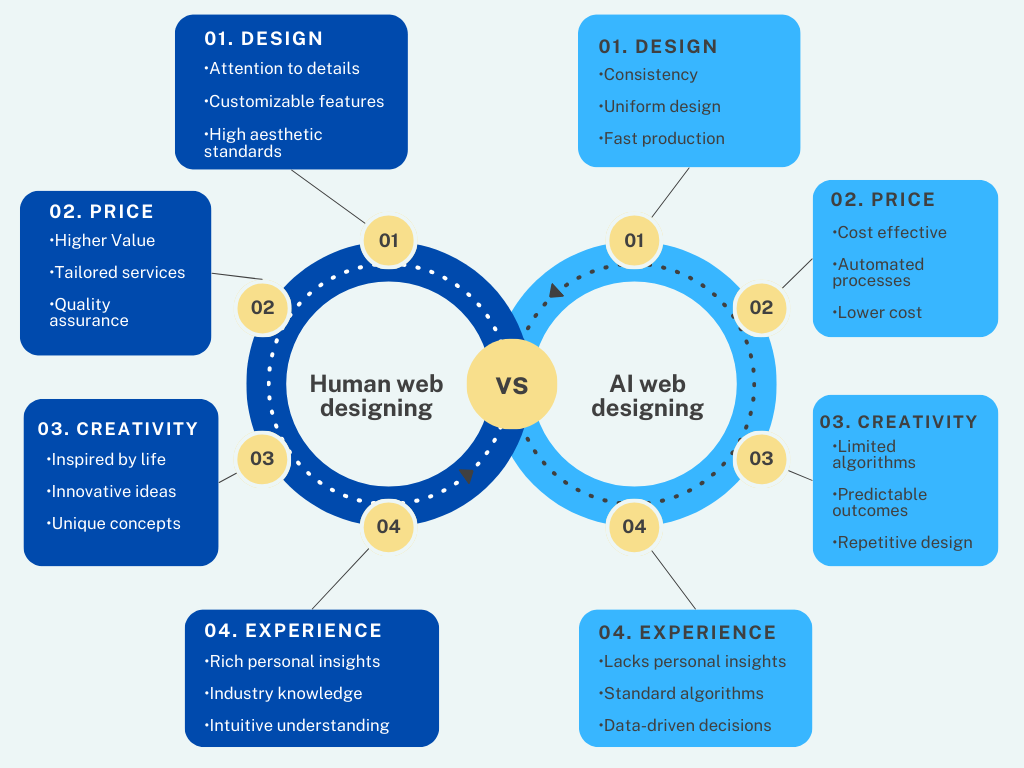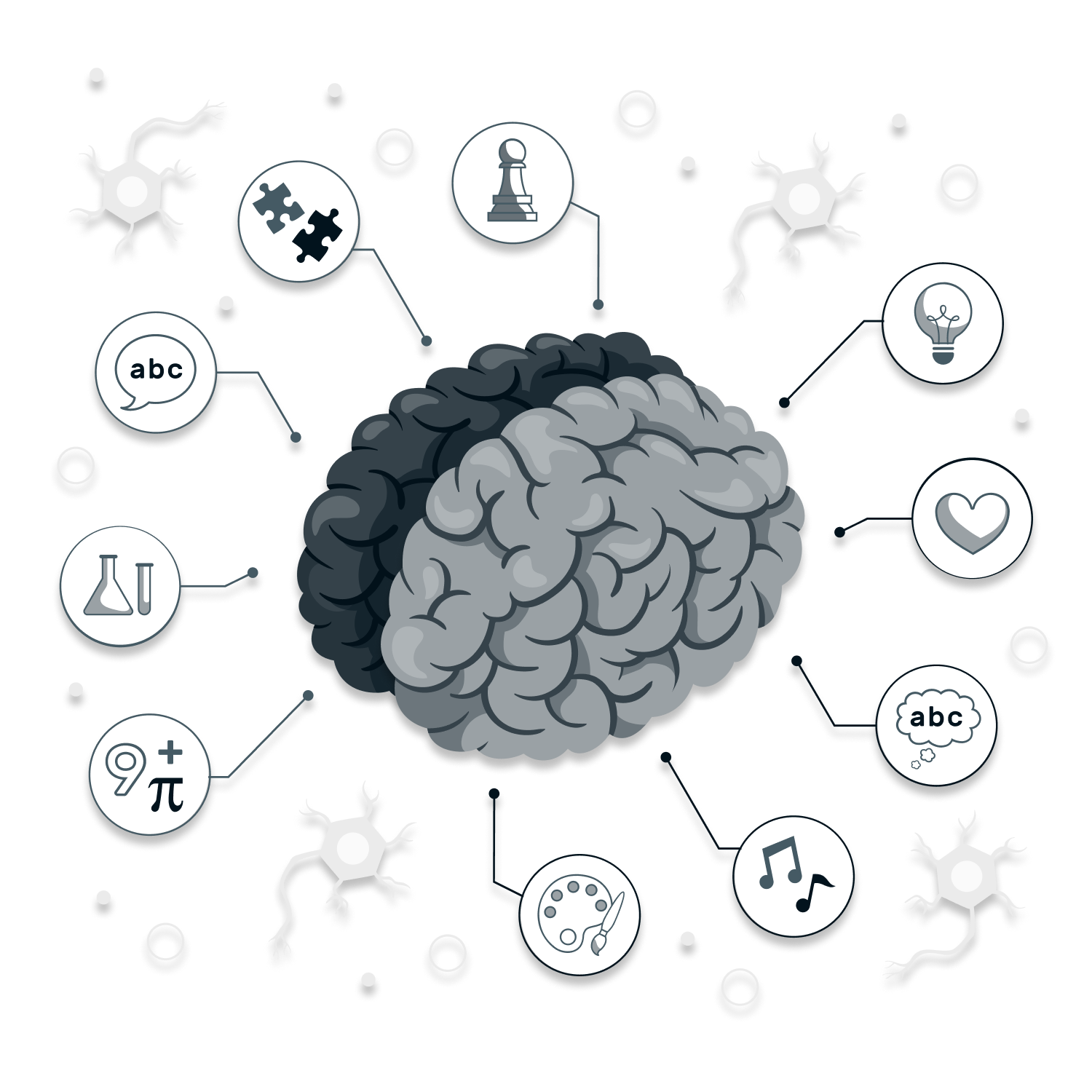The battle between AI-powered and human-made site design has gained popularity in the quickly changing digital ecosystem.As artificial intelligence (AI) is developing at a high speed, it makes the question: Can AI really take the place of human web designers‘ strategic acumen and artistic flair? We’ll understand every aspect of the case to make the evidence for why human web design is still preferable than AI web design in this blog article.

The Human Touch: Capturing the Essence of Design
The Importance of Strategic Thinking
Good website design is a smart process that links online experiences with a business’s goals and ideal reputation. It’s not simply about how a website appears. Expert human web designers specialize at this important component of the design process. They are able to look at complicated information, identify problems with users, and develop solutions that will benefit the company in the long run.
AI web design tools can create visually appealing layouts and designs, but they sometimes lack the capacity to make the essential strategic choices required for a website to make a big impression. These systems may recommend solutions that aren’t customized to each company’s unique requirements and goals because they depend on the data and algorithms they were educated on.
On the other hand, human web designers have full knowledge about user behavior, marketing, and industry best practices. They are able to organize, conduct in-depth research, and work with stakeholders to give a broad, personalized web design plan that meets the main objectives of the customer. Human web designers capacity for strategic thought and problem-solving separates them from AI web designers
Adaptability and Continuous Improvement
With new technologies, design trends, and customer needs developing quickly, the field of web design is always changing and introducing new functionalities. Human web designers are quick and adaptable enough to move around these changing conditions, always improving their skills and keeping up with the most recent developments in the field.
However, the variety of learning information and supporting algorithms restricts AI web design tools by nature. Even while they might be able to produce aesthetically pleasing designs, they frequently find it difficult to stay up with the web design industry’s fast-paced environment, falling behind in terms of user preferences, cutting-edge design techniques, and developing technology.
Human web designers are able to change and improve their skills in response to changing customer needs because of their continuous education, experimentation, and cooperation with colleagues in the field. To keep their clients’ websites current, competitive, and interesting, they might experiment with modern technologies, apply new design concepts, and achieve constant improvement.
The Importance of Human Empathy and Creativity
Understanding consumers’ needs and emotions, as well as building a closer connection with them, is the basis of good web design. Creating experiences that generate feelings in visitors is more important than just making things look good. Web designers are different from AI-based solutions by placing importance on people.
Web designers have a unique ability to put themselves in users’ positions and understand their problems, inconveniences, and goals. Their deep understanding allows them to design user interfaces that are simple and meet the preferences of the target audience. They guarantee a seamless and enjoyable browsing experience by detecting user needs.
Furthermore, AI-powered technologies just cannot match the creativity and uniqueness that human web designers bring to their work. They have the ability to think creatively, try new approaches to design, and push past the boundaries of what’s possible in the digital world. In a sector where customers are continuously looking for new, exciting, and unforgettable experiences that entertain and surprise them, this creative touch and innovative mentality are important.
AI technologies can create beautiful websites, but they are not as capable as people in grasping human emotions and behavior. For this reason, using human site designers is still essential. They create websites that people genuinely enjoy using by utilizing their imagination and smart reasoning. Hence, even though AI might be useful, human interaction is what really sets websites apart.
The Synergy of Human and AI Web Design: A Winning Combination
It’s important to keep in mind that there is more than one side in the argument between AI-powered and human web designers. In actuality, the most successful web design solutions frequently result from a balanced combination of technology innovation with human experience.
Artificial intelligence (AI)-powered technologies can be a useful tool for human web designers. They may replace boring jobs, simplify some tasks, and offer data-driven insights that guide the design process. But rather than taking the position of a human web designer, these technologies should be seen as an addition to their skill set.
Web design teams can create an effective cooperation that combines the best elements of human and AI-powered techniques by using the abilities of both. AI-driven web design technologies can help human web designers work more efficiently, automate routine tasks, and gain data-driven insights—all while maintaining the creative, calculated, and human elements that make great online design.
In this way, the synergy of human and AI can lead to the creation of truly innovative, user-centric, and impactful web experiences that captivate audiences and drive tangible business results.
Conclusion
The argument for the benefit of using human web designers is still appealing and strong in the continuous conflict between humans and machines. They set themselves apart from AI web design, which are limited by their programming and training data, by being able to incorporate creativity, strategic thinking, adaptability, and compassion into the design process.
Artificial intelligence (AI)-powered tools can be helpful collaborators in the web design process, but they cannot take the place of human web designers’ special abilities and skills. Web design teams may unlock the full potential of digital experiences by embracing the complementary characteristics of both human and AI techniques. This allows them to create solutions that attract, engage, and inspire their target audiences.
The human web designer is still a valuable resource in the ever-evolving web design industry, serving as a shining example of creativity, strategic thinking, and user-centric design. Those who can effectively combine the power of humans and machines will lead the web design industry in the future and create the foundation for the next wave of remarkable digital experiences.




